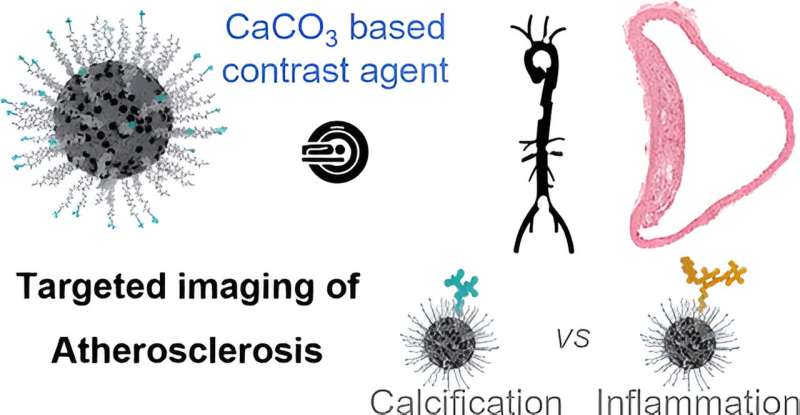This article has been reviewed according to Science X's editorial process and policies. Editors have highlighted the following attributes while ensuring the content's credibility:
fact-checked
peer-reviewed publication
trusted source
proofread
Enhancing atherosclerosis diagnosis using ultrasmall calcium carbonate nanoparticles

Atherosclerosis is characterized by the hardening of blood vessels, especially certain arteries, due to the local buildup of fibers and lipids (mainly cholesterol) in the inner wall of an artery, causing it to narrow. It is a complex disease that can trigger life-threatening events, such as myocardial infarction and ischemic stroke.
Despite the severity of this disease, conventional diagnostic protocols lack specificity and fail to predict the type of atherosclerotic lesion or the risk of plaque rupture.
As the CIC biomaGUNE Ikerbasque research professor Jesús Ruiz-Cabello explained, "diagnosing plaque vulnerability remains a challenge due to the lack of effective diagnostic tools. To address this problem, technologies, such as the noninvasive medical imaging of atherosclerotic plaque using customized nanotechnology solutions, are emerging. However, due to the porosity of the plaque, obtaining images using nanoparticles remains a difficult task."
A CIC biomaGUNE team led by Ruiz-Cabello, together with Ikerbasque research professor Susana Carregal –both members of the biomedical research networking center CIBERES–, has developed contrast agents to achieve the selective molecular imaging of atherosclerotic plaques using ultrasmall amorphous calcium carbonate nanoparticles. Calcium carbonate (CaCO3) is a safe, biocompatible material with a long history of use in textiles, cosmetics and foodstuffs.
In this work, published in the journal ACS Nano, the team compared various nanoparticles specifically designed for different features of atherosclerosis (such as calcification or inflammation), which provide useful information about the phase or stage of plaque development.
"We managed to modulate the biological interactions and contrast of these nanoparticles for various imaging techniques, including magnetic resonance imaging, by carefully designing their physico-chemical properties," said Carregal. "Our work shows that Gd(III)-doped amorphous calcium carbonate nanoparticles are an effective tool due to their high magnetic resonance contrast and physico-chemical properties."
The novelty and impact of the work lies in the combination of materials science, molecular imaging and biomedicine to design safe, biocompatible contrast agents with advanced properties for magnetic resonance imaging.
"Our results demonstrate the potential of this simple yet groundbreaking nanoprobe, which could inspire new designs of contrast agents for atherosclerosis and other types of diseases, and offer the possibility of formulating new theranostic agents (that can be used for therapeutic as well as diagnostic purposes)," they concluded.
More information: Lydia Martínez-Parra et al, A Comparative Study of Ultrasmall Calcium Carbonate Nanoparticles for Targeting and Imaging Atherosclerotic Plaque, ACS Nano (2023). DOI: 10.1021/acsnano.3c03523
Journal information: ACS Nano
Provided by CIC biomaGUNE





















